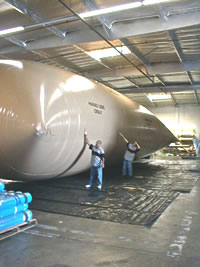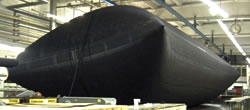The “Flat sheet” bag
Using one of the easiest manufacturing processes, two identically sized and (rectangular) shaped sheets of rubber of thermoplastic material are placed on top of each other. At least one of these sheets shall be provided with an air-connection to allow for the envisaged inflation. Bonding these two sheets along their four edges in an airtight manner provides an enclosed circumference with an air transfer provision.


Right: Inflated bag made from 2 rubber sheets, produced using a vulcanization process 2-dimensionally.
Left: Inflated bag madefrom 2 TPU sheets, produced by using an ultrasone welding process 2-dimensionally.
When inflated, a “pillow” shaped bag will be formed. A bag of this shape is not identical to the shape of any type of tank, including cylinder shaped tanks which are commonly used. Cylinder shaped tanks have either concave or flat end plates.
The use of these flat sheet type of bags in cylinder shaped tanks in experiments identified the following possibilities:
Flat sheet bags which cover the length of the tank matching the centre line length. The corners of the bag are forced against the inner tank-wall and will therefore be folded and not stretched during inflation of the bag in a tank.
The bag may be dimensioned smaller than the tank it is applied in, or have its corners cut off, such that the corner points do not or only barely touch the inner tank wall upon inflation. The bag material, when the bag is inflated, thus remains stretched over its entire surface.
Experimental testing of bags of various sizes in a mobile, transparent Perspex test tank revealed that:
(i) The larger type of flat bags, allowing their corners to be pressed inward, such that the bag fits inside the tank, will deform when subjected to dynamic loads of the liquid. This because these bags lack rigidity and cannot withstand, or cater for the transfer, of the dynamics related forces. Once the corners deform, the flat bag no longer is in a fully stretched condition, which reduces the resistance against deformation.
(ii) The application of a smaller, fully stretched, inflated bag, made of two flat sheets, in a cylinder type of tank results in liquid accumulation in between the end-plates of the tank and the bag. Furthermore, the outside of the inflated bag is completely in contact with the liquid except for an area at the top of the bag which is forced against the top of the inner tank wall by upward forces resulting from the submersion of the bag in the liquid. A type of flat bag, smaller than the tank it is placed in, will not deform and will remain stretched, but will move within the tank when subjected to dynamic liquid forces.

